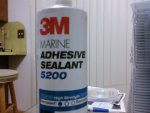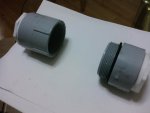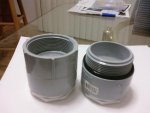I am probably too late to assist STN with this advice, but here are some of my finds / tips to help out in the future:
Not many adhesives adhere well to HDPE (High Density Poly Ethylene) plastic, which is what most all plastic drums are mfg from. Actually, there is NO adhesive that is truly made for this purpose because HDPE has a restrictive polymer string constitution. This means that these plastics are chemically resistant to solvent based adhesives. Their rather inert quality is what makes them desirable for specific uses (since chemicals do not bond, adhere or absorb into them).
3M has a few products that will work fairly well. See my pics below for what I used for my system (5200 Marine Sealant/Adhesive). This adhesive works like RTV, but it is a polyeurethane based product and requires 7 days to cure fully. But, it will actually cure under water. I let it air cure for three days before trying it with water in the tanks and it worked very well. Cheapest place I have found for this adhesive is Jamestown Distributors Boating and Building Supplies. About $13 per 10 oz cartridge.
3M also now has a plastic adhesive that will join polyethylene. The Mfg. No. is 4693, or 4693H for a thicker glue. Several industrial supply catalogs carry this or you can locate it on the internet. It runs about $7.00 or $8.00 a 5 oz tube. It sticks to the poly quite well but does not make a chemical bond. The adhesive and poly must be above 65 degrees when using. To use put an even coat on both surfaces. Let dry until tacky but does not transfer when touched, takes only a few seconds, then press together.
For the most part, when attaching fittings to HDPE plastic, you need to use mechanical fasteners (i.e. screws, bolts, threaded fittings with seals, etc.) See the fittings in my attached pix below. These are PVC electrical conduit fittings. Use these instead of standard PVC threaded fittings because the threading is not tapered and does not bottom out. This way you may tighten the fittings snugly against the wall of the HDPE tank. You can use a large O-ring on the water side of the tank to seal it or use the 3M 5200 marine sealant, but I don't recommend using both. I tried this and the O-ring just got pushed out of the way because the sealant lubricated the O-ring and allowed it to slip out of place. I opted to remove the O-rings and just use the sealant alone. With the mechanical force from the threaded fittings, this sealant remains in contact and forms a watertight seal that won't dislodge with vibration. I used the 3M 5200 sealant on all the fittings in my tanks.
Here is a video of another adhesive that REALLY works well with HDPE, check it out as it is quite informative.
http://www.tapplasti...521014995032tim
Gordy




